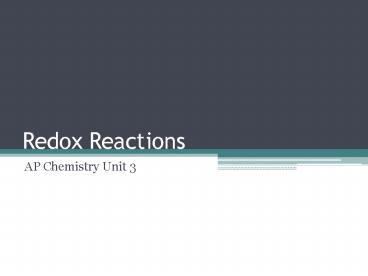Redox Reactions - PowerPoint PPT Presentation
1 / 12
Title:
Redox Reactions
Description:
Redox Reactions. AP Chemistry Unit 3. Titration: volumetric analysis to determine ... many mL of 0.610 M sodium hydroxide solution are needed to neutralize 20.0 mL ... – PowerPoint PPT presentation
Number of Views:340
Avg rating:3.0/5.0
Title: Redox Reactions
1
Redox Reactions
- AP Chemistry Unit 3
2
Titration volumetric analysis to determine
concentration lab work!
- Stoichiometric point equivalence point
- Moles of acid (H) moles of base (OH-) in
acid-base titrations - How many mL of 0.610 M sodium hydroxide solution
are needed to neutralize 20.0 mL of 0.245 M
sulfuric acid solution? - Write a balanced equation
- 2. Identify moles of one reactant.
- 3. Use mole ratios to predict moles of other
reactant. - 4. Solve for Molarity or mass.
3
2NaOH H2SO4 ? 2 H2O Na2SO4
- 0.245 M ___x____
- 0.0200 L
- 0.00490 moles
- 0.00980 moles
- 0.00980 moles 0.610 M
- x
- 0.0161 L 16.1 mL
- since we are finding molarity of entire
reactant (not net ionic) use the molecular
equationusually common in titration problems
4
Redox reaction transfer of electrons
- Reduction process of gaining electrons becoming
more negative - LEO the lion
- Oxidation process of losing electrons becoming
more positive - goes GER
5
Oxidation and Reduction
- Reactant reduced is the oxidizing agent.
- H oxidizes Zn by taking electrons from it. (e-
acceptor) - Reactant oxidized is the reducing agent.
- Zn reduces H by giving it electrons. (e- donor)
6
Oxidation Numbers
- In order to keep track of what loses electrons
and what gains them, we assign oxidation numbers.
7
Oxidation numbers charge of an atomCa2 F-1
Mn7
-2
-2 x 4 -8
- K2SO4
- CO3-2
- ___ 3(-2) -2
- Fe3O4
- 3(__) 4(-2) 0
- Rules
- Elements 0
- Hydrogen 1 except in metal hydrides (NaH), then
it is -1. Placement is the key! - Oxygen -2 except in peroxides (H2O2 O -1)
- In a compound, oxidation numbers must balance out
to net charge of zero.
2(1) ___ (-8) 0
8
Balancing simple redox reactions
- Cu2 Al ? Cu Al3
- 1. Cu2 ? Cu Al ? Al3
- 2. no changes
- 3. 2e- Cu2 ? Cu
- Al ? Al3 3e-
- 4. (2e- Cu2 ? Cu)3
- (Al ? Al3 3e-)2
- 5. 6e- 3Cu2 ? 3Cu
- 2Al ? 2Al3 6e-
- 2Al 3Cu2 ? 3Cu 2Al3
- 2(0) 3(2) 3(0) 2(3)
- Half reaction method
- Write ½ reactions.
- Balance atoms, if necessary (except H O)
- Balance charges by adding electrons.
- Multiply (if needed) to cancel electrons.
- Check work charges atoms
9
Half-Reaction Method
- First, we assign oxidation numbers.
Since the manganese goes from 7 to 2, it is
reduced and changes color.
Since the carbon goes from 3 to 4, it is
oxidized.
10
Balancing redox reactions in acidic solutions
MnO4-(aq) C2O42-(aq) ??? Mn2(aq) CO2(aq)
- 1. C2O42- ??? CO2
- MnO4- ??? Mn2
- 2. C2O42- ??? 2 CO2
- 3. MnO4- ??? Mn2 4 H2O
- 4. 8 H MnO4- ??? Mn2 4 H2O
- 5. C2O42- ??? 2 CO2 2 e-
- 5 e- 8 H MnO4- ?? Mn2 4 H2O
- 6. 5 C2O42- ??? 10 CO2 10 e-
- 10 e- 16 H 2 MnO4- ? 2 Mn2 8 H2O
- 16 H 2 MnO4- 5 C2O42- ???
- 2 Mn2 8 H2O 10 CO2
- Write ½ reactions
- Balance all atoms except H O, if needed.
- Balance oxygen atoms by adding H2O to one side
since aqueous. - Balance hydrogen atoms by adding H
- Balance electric charge by adding electrons
- Make electrons equal, to cancel
- Check atoms charge.
11
Balancing redox reactions in basic solutions
- Zn VO3-1 ? VO2 Zn2
- Zn ? Zn2
- VO3-1 ? VO2
- 3. VO3-1 ? VO2 2H2O
- 4 H VO3-1 ? VO2 2H2O
- 2 (e- 4 H VO3-1 ? VO2 2H2O)
- Zn ? Zn2 2 e-
- 6. 2e- 8 H 2VO3-1 ?2VO2 4H2O
- Zn ? Zn2 2 e-
- Zn 2 VO3-1 8H ? 2VO2 4H2O Zn2
- 8. 8 OH- 8 OH-
- 8 H2O
- Zn 2 VO3-1 8H2O ? 2VO2 4H2O Zn2 8
OH- - Zn 2 VO3-1 4H2O ? 2VO2 Zn2 8 OH-
- Write ½ reactions
- Balance all atoms except H O, if needed.
- Balance oxygen atoms by adding H2O to one side
since aqueous. - Balance hydrogen atoms by adding H
- Balance electric charge by adding electrons
- Make electrons equal, to cancel
- Check atoms charge.
- Now add OH- to both sides to eliminate H
12
Half-Reaction Method
- Consider the reaction between MnO4- and C2O42-
- MnO4-(aq) C2O42-(aq) ??? Mn2(aq) CO2(aq)
- This is an example of a redox titrationnext
lab!































